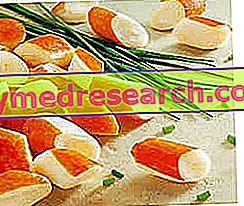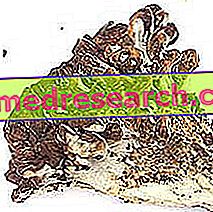Generality
Surimi is a culinary preparation that is part of the Japanese national tradition. Originally, before its commercialization on a large scale, surimi was produced in a simple and express manner, therefore, it was distinguished by its reduced shelf life.

The original Japanese recipe for the preparation of surimi is very simple: it is a "battuto" (minced with a knife) of Pollack Nordic cod meat cooked in boiling water (boiled), leveled and subsequently corrected in flavor.
Home-made Surimi
X Problems with video playback? Reload from YouTube Go to Video Page Go to Video Recipes Section Watch the video on youtubeIndustrial surimi
Although (at the beginning) surimi might appear to be a nutritionally good quality dish, the relative (and current) "industrial" surrogate does not seem to resemble it even remotely.
The "canned surimi" is a highly artificial food, manipulated and rich in additives; it comes in the form of orange-colored "sticks", has a taste resembling crab or shrimp, and is produced by composing a homogeneous dough that is subsequently leveled (then laid out like a sheet of dough), rolled up on itself and cut into various sizes.
Ingredients
Certainly, by eating a surimi, the kind readers will have already wondered (otherwise, it would be the case to do it!): " Who knows how they do it? ... the ingredients will certainly be all processing waste! " ...
EXACT !
Surimi, as we know it today, despite being a shellfish-flavored food, is produced from fish pulp (pinnuto, of course); are mainly used trimmings and remnants of processing of some fish species, including: cod, Asian carp, some nemipteri (vaguely resembling mullet), suro and mackerel.
Nothing serious; it is known that, from a nutritional point of view, it is more advisable to eat fish than shellfish among the fishery products. However, in the industrial surimi the percentage of fish pulp is reduced to a measly 30-40% ... and the remaining 60-70% of what it consists of?
Once the trimmings are cooked and ground, proceed with the amalgamation and addition of the surimi mixture; the other ingredients are: starchy flours (for example potato starch), egg whites, rapeseed or palm oil and spices. Flours and egg whites, used for their relative "binder" capacity, make it possible to increase the consistency of the dough which must be spread (like a sheet), rolled and dirty.
Among the additives used in the mix of industrial surimi we find: thickeners, flavor enhancers (monosodium glutamate) and aromas (crab, shrimp, smoked salmon, various shellfish).
Nutritional considerations
Taking a look at the ingredients used for the preparation of surimi, it quickly leaps to the eye that it is absolutely not the product that was intended to be purchased.
Nutritional values
 | |
| Power | 99, 0kcal |
| Protein | 15.2 g |
| Grassi | 0.9 g |
| Carbohydrates | 6.9 g |
Minerals (present in significant quantities): | |
| Sodium | 143 mg |
| Phosphorus | 282 mg |
| Potassium | 112 mg |
Vitamins (present in relevant quantities): | None! |
In short, it is possible to state that surimi is a food with a moderate calorie content; the lipid percentage is almost insignificant but still deriving also from palm and rapeseed oils (known for their poor nutritional quality). Moreover (considering that it is a product of animal origin) the amount of protein is not particularly high, while the carbohydrates derived from starch flour take up 30% of the total energy.
Surimi is not a high-calorie or hyperlipidic food, but this does not mean that it is a good quality product; they observe the profile of salts and vitamins we realize that it is a food almost "empty", therefore poor in essential molecules, which however shows a quantity of sodium that makes it unsuitable for the nutrition of hypertension (hypertension patient blood).
In conclusion, using surimi as a substitute dish for fish is not a particularly advantageous choice since the nutritional characteristics are not good and the cost is equal to or greater than that of many objectively preferable fish species.



